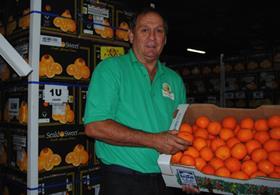
By 13 September the South African summer citrus industry expects more than 80 per cent of all projected shipments will have arrived in Philadelphia.
“The South African summer citrus season is progressing according to plan with 30,583 tons of Clementines, navel oranges and grapefruit shipped to date,” said Gerrit van der Merwe, Chairman of the Western Cape Citrus Producers’ Forum (WCCPF)
All of the shipments enter the US through the Port of Gloucester, N.J. along the Delaware River in greater Philadelphia.
An additional 9,769 tonnes will arrive in the next six to eight weeks for a total of 40,352 tonnes shipped for the 2010 season.
With the season entering its final phase, the focus will very much be on Late Navels and Midknight Valencias, although the two latest vessels also carry significant volumes of late mandarins.
All reports indicate that recent sales weeks have been good and demand strong. With the summer holidays something of the past, demand is expected to be strong for the final part of the season.
The latest arrivals in Philadelphia on the Seatrade vessel Prince of Waves delivered 2613 pallets of navels, 103 pallets of Midnights and 569 pallets of easy peelers.
The volume of Midknights will increase significantly with the arrival of the next vessel, Chanquinola Bay, on 13 September, carrying 1178 pallets of Midknights, along with 1871 pallets of navels and 657 pallets of easy peelers.
Gerrit van der Merwe, who represented growers in Philadelphia during the past three weeks, has expressed satisfaction with the development of the 2010 season.
“In general we have maintained good rate of sale which is putting us in good shape for the rest of the season,” he noted.
“The volume we will achieve this season represents a 20 per cent increase over 2009 and we expect all our fruit to be sold by the first week of November.”
Mr Van der Merwe said the WCCPF made a strategic decision at the end of last season to modify its supply chain, leading to more frequent but smaller shipments of fruit.
“Instead of in the past a shipment arriving every three or even four weeks, we chartered smaller reefer ships which have been docking every 10 to 12 days. This has worked very well for us as we have been able to satisfy demand on a continuous basis, ensuring that retailers have a reliable source of supply throughout the season.”
He added that consumers have responded by buying and enjoying the fresh, delicious fruit with its excellent brix (sweetness) to acid (tartness) ratio.
“Other providers offer fruit with a high acid taste which is not in favour among US consumers. That sweet flavour combined with the good eating quality of our fruit’s firm juicy texture has become a favourite of US consumers.”
However, the South African industry’s plans to ship bigger volumes earlier in the season to the West Coast have been somewhat hampered by the overflow of a huge Californian navel crop.
“It shows again that our strategies are always impacted on what happens in California,” says Mr Van der Merwe.
There are now only two conventional reefer shipments left before the conclusion of the season at the end of October, with the final ships set to depart from Cape Town on 26 September, arriving in Philadelphia in mid-October.
In between these vessels and after the last reefer vessel growers will utilise container shipments to fill the gaps.



